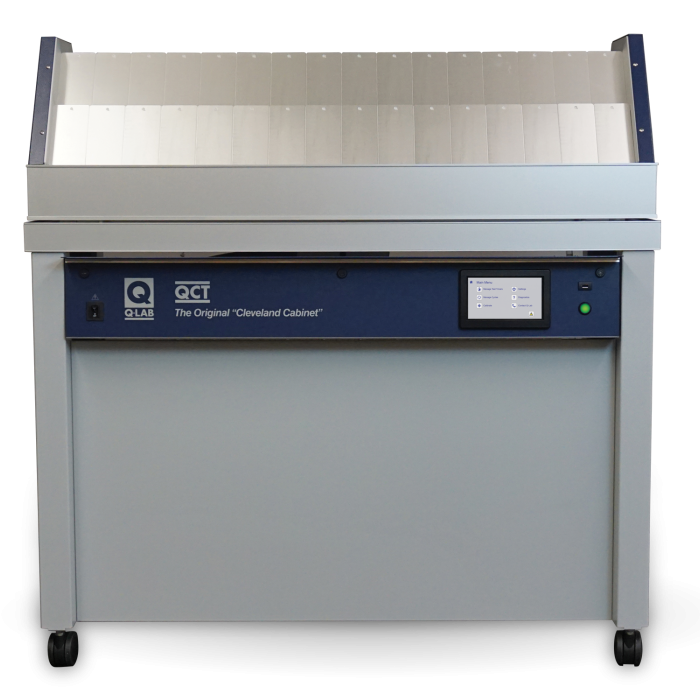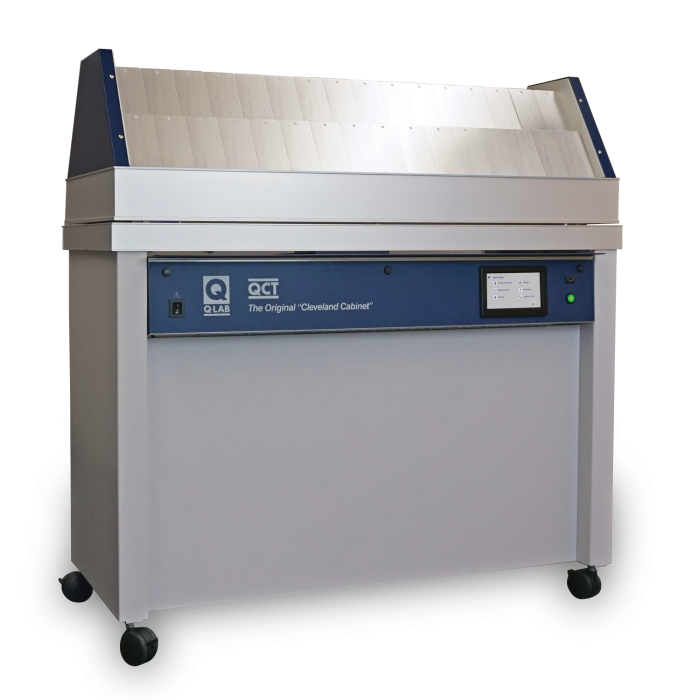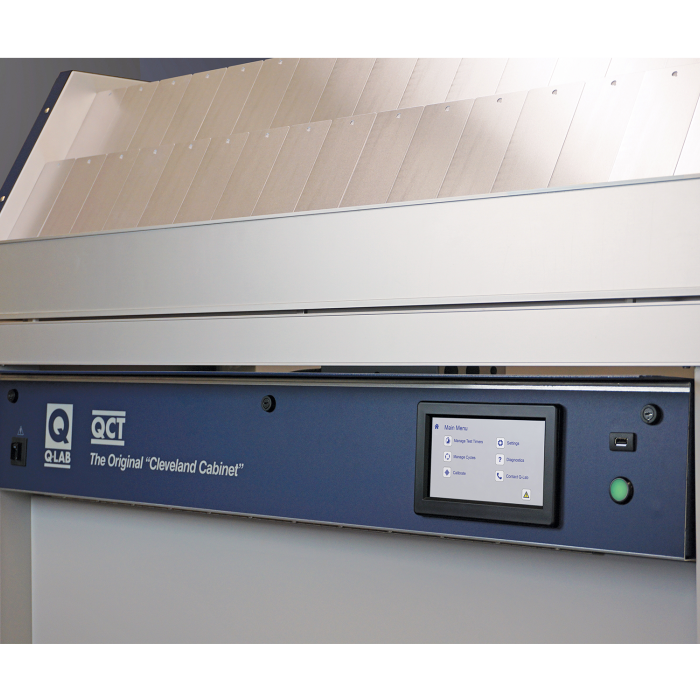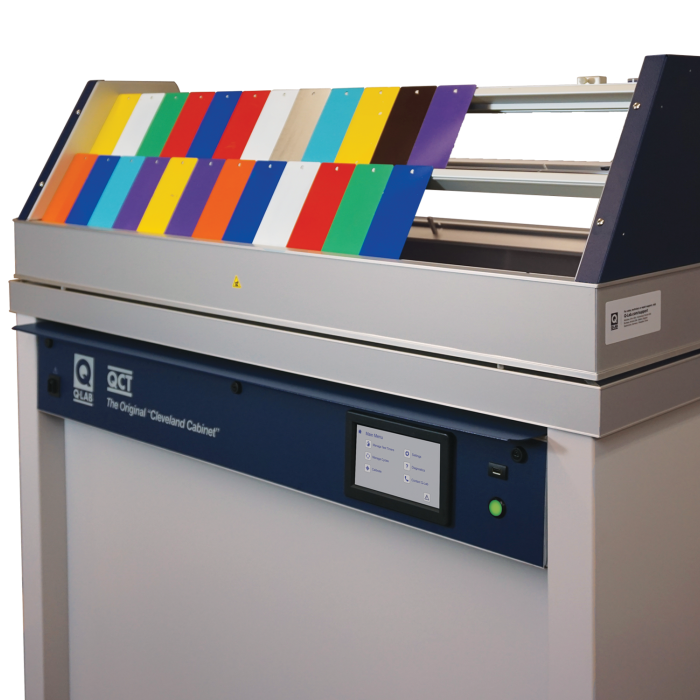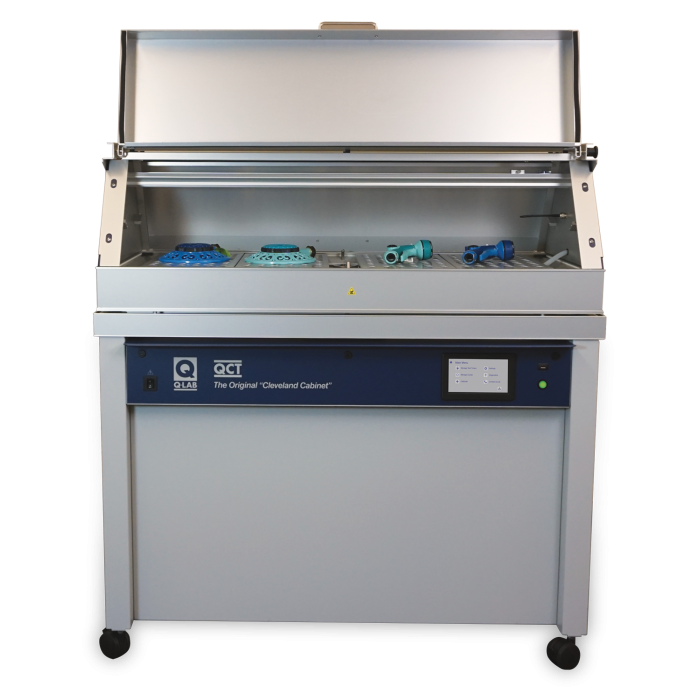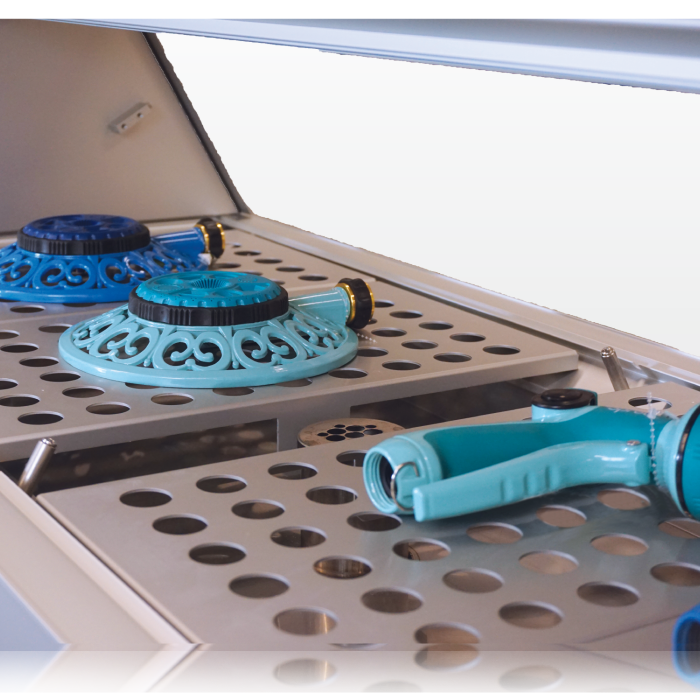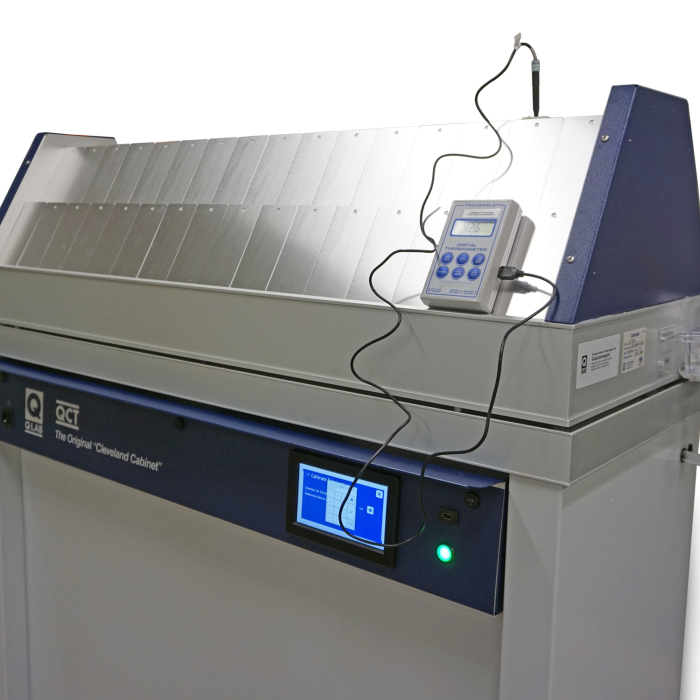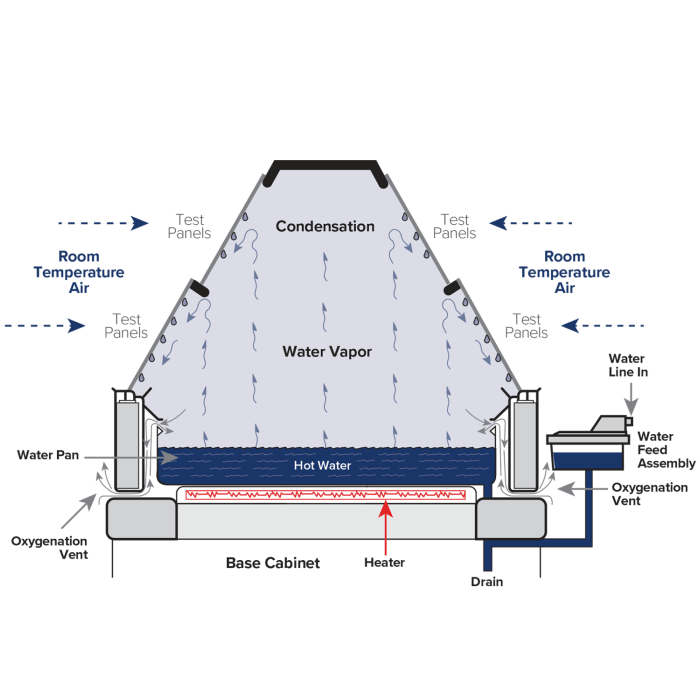QCT
Condensation Tester
The QCT condensation tester – “The Original Cleveland Cabinet™” - was first introduced in 1956. The QCT simulates the damaging effects of outdoor moisture attack by condensing warm water directly onto test specimens. In a few days or weeks, the QCT tester can reproduce the damage due to moisture that occurs over months or years outdoors.
The QCT tester is fast, easy to use, and affordable. It uses 100% condensing humidity to simulate and accelerate damage caused by rain and dew on metals, paints, and organic materials. This degradation is accelerated relative to natural exposures by increasing moisture temperature. The QCT tester replaces water immersion and ordinary (non-condensing) humidity tests.
The QCT condensation tester is used in thousands of labs in over 50 countries. It is the simplest, most reliable, and easiest-to-use condensation tester available.
Effects of Outdoor Moisture
Water is a common enemy to most materials. It causes metals to corrode, organics to decompose, and structures to disintegrate. Condensation is water that has been distilled, mixed with the atmosphere, and saturated with oxygen. This type of moisture has also been called “aggressive water”, because it carries oxygen with it as it contacts a material or diffuses through a coating. Studies show that materials outdoors are exposed to an average of 12 hours per day of condensed water in the form of dew.
The QCT Condensation Tester
The QCT tester uses 100% condensing humidity to simulate and accelerate damage caused by dew on metals, paints, and organic materials. It accelerates degradation relative to natural exposures by increasing moisture temperature.
The QCT tester requires only ordinary tap water, which becomes pure distilled water in the process of evaporation from the water pan and then condensing onto the specimens. The tester's innovative design utilizes room air cooling to create a temperature differential across the thickness of the specimens. This temperature differential is a necessary element for condensation to occur. Learn more by reading The QCT Condensation Tester: Why It Works.
It is important to note that the QCT tester is fundamentally different from a typical humidity tester, although optional humidity enclosure boxes can be used with the QCT to reproduce enclosed humidity testing.
Variable Exposure Cycles
The user is able to program the QCT tester to create static, 100% condensing humidity, or to cycle between hot condensation and dry-off. The temperature’s range extends from room temperature to as high as 70 °C. The system allows for the selection of almost any desired wet/dry exposure cycle through a programmable interface. The cycle options range from the subtle wetness of an almost invisible dew a few degrees above room temperature, to a continuous, high-temperature, running condensate. See the QCT Specification Bulletin for more details on operating capabilities.
Freezing accelerates some failures. For a freeze/thaw cycle, panels can be manually removed from the QCT while wet, immediately frozen, and then reinserted into the tester following freezing.
Fast and Versatile
The QCT tester can be used to:
- Screen paints for blister resistance over a weekend at 55 °C
- Evaluate oil-based rust inhibitors in less than 120 hours at 38 °C
- Rate effectiveness of mill-applied oils in only a day
- Test surface reactivity of cold-rolled and galvanized steel in hours
- Test wood finishes for blistering, moisture and mold resistance
See the QCT Brochure for more details.
Easy To Use
The QCT tester provides instant blister or corrosion testing - just plug it in and add water. The unit can be placed anywhere in your office, lab, or plant. The heat and water vapor produced by the QCT tester is about the same as that produced by one additional person in the room. Also, the test panels on a QCT unit may be inspected as often as you want, without altering test conditions. Just remove the panel and put a blank in its place. The QCT tester is completely automated and can operate continuously, 24 hours per day, 7 days per week. Other features include:
- Remarkably simple user interface in 17 user-selectable languages: English, Spanish, French, German, Italian, Japanese, Chinese, Korean, Czech, Dutch, Polish, Portuguese, Russian, Swedish, Thai, Turkish, and Vietnamese
- Built-in Ethernet connection for data logging
- Comprehensive self-diagnostic warnings and service reminders
Affordable
The QCT tester is economical to purchase and to operate. It uses ordinary tap water for condensation.
Standards Compliance
The QCT tester conforms to several standards, including:
- ASTM D4585, Testing Moisture Resistance of Coatings with Controlled Condensation
- ISO 6270-1, Paints and Varnishes - Condensation (single-sided exposure)
- ISO 6270-2, Paints and Varnishes - Condensation (in-cabinet exposure with heated water reservoir)
- BS 3900, Part F9, Determination of Resistance to Humidity (Continuous Condensation)
Versatile Programming
The QCT tester has a programmable dry-off system, which works by blowing heated air into the test chamber. A combination of wet and dry periods can be programmed through the use of a full-color touchscreen display. Temperature is controlled through an easily-calibrated chamber air temperature sensor.
Specimen Capacity
The QCT tester has a sample capacity of 62 panels at 75 × 150 mm (3 × 6 in) or 48 panels at 100 × 150 mm (4 × 6 in). It can achieve temperatures ranging from room temperature to 70 °C. Specimens are mounted at 60° from horizontal. See the QCT Specification Bulletin for more information.
Water Delivery
The QCT tester’s water consumption is approximately 2 liters of ordinary tap water per day. It has an automatic water feed that connects to a supply through 6 mm (0.24 in) plastic tubing. It has a corrosion-resistant anodized aluminum construction, with a stainless steel water pan.
Software & Operations
The QCT accelerated weathering tester’s display is designed to be both functional and easy-to-use. QCT testers feature a full-color touchscreen display that can be programmed in 17 user-selectable languages (English, French, Spanish, Italian, German, Chinese, Korean, Japanese, Czech, Dutch, Polish, Portuguese, Russian, Swedish, Thai, Turkish, and Vietnamese). This system includes complete self-diagnostic error checking, constantly monitoring the status and performance of all systems. It also displays tester error messages and routine service reminders as needed. The multicolor LED status indicator light updates users on the tester’s operational state at a glance.
An external USB port on every QCT tester allows users to perform software upgrades quickly to address key performance issues. For quality systems that require documented proof of test conditions, this USB port can also be used to download tester performance history. Data from the USB export can be emailed directly to Q-Lab's technical support desk for expert troubleshooting and diagnostics.
Enclosed Humidity
The QCT condensation tester can be equipped with optional 3" (76 mm) deep humidity enclosure boxes on both sides. This allows for fully-enclosed humidity cabinet exposures as described in ISO 6270-2. Differences between one-sided and enclosed humidity are explained in this Technical Bulletin.
Space Saver Frame
In labs where space is a premium, QCT testers can be stacked two-high with Space Saver Frames. QCT space saver frames allow sufficient clearance between the upper and lower units. Frames are available for compatibility with all new and existing QCT testers.
Looking for more information on the QCT? Browse our extensive document library for technical articles, technical bulletins, and more. Click here to view translated documents.
More QCT Resources At Your Fingertips
Document Library
Browse Q-Lab’s extensive library of weathering testing literature and technical content.
Education
Check out blogs, case studies, articles, and webinars to build your knowledge of weathering testing.
Standards
Review setup and performance information on key international and OEM test standards from ASTM, ISO, SAE, JIS, GB, and more.
